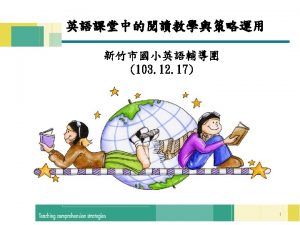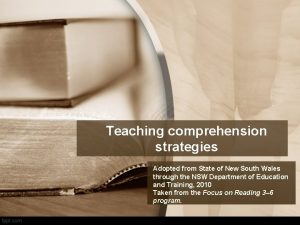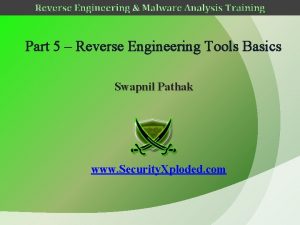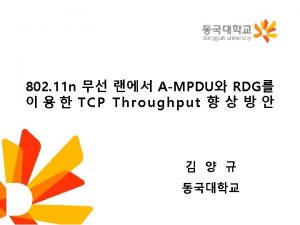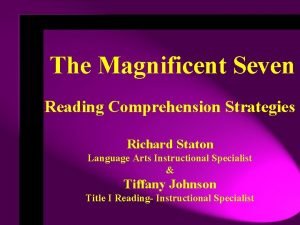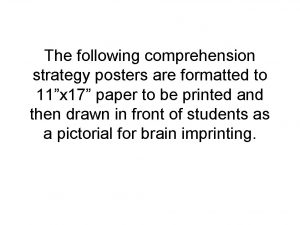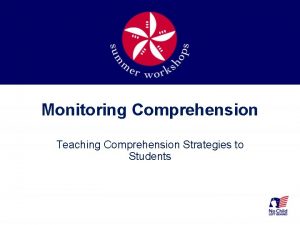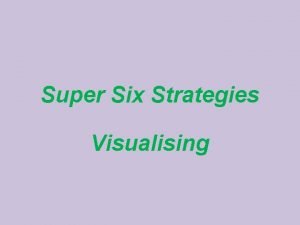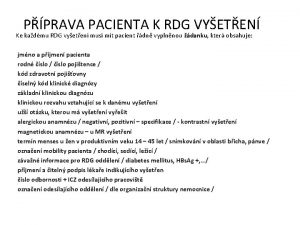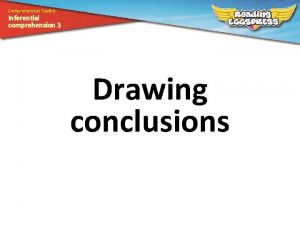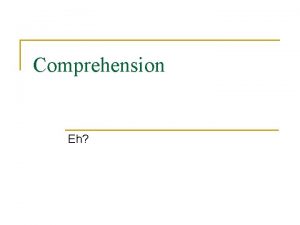Six Strategies for Teaching Comprehension Stephanie Woods RDG








- Slides: 8

Six Strategies for Teaching Comprehension Stephanie Woods RDG 500 Week 6 Application

Background Knowledge Making connections by using background knowledge to the text is a pre-reading strategy suitable for students of all ages. Students use this strategy to think about past experiences and knowledge which relate to the text. When students are able to use this skill it helps guide their comprehension of the text. The strategy does work as I have used it with students in the past. It works because if a student is having difficulty before they read but can make a connections to what they already know or an experience they have had, it makes the current text easier to understand. According to Fisher, Frey and Lapp (2009) “ the challenge related to background knowledge is that we can’t directly teach it” (p. 29). I would try to teach this strategy at the very beginning of the year because it can be used all year long. I would use a book about the First Day of School. All students have had experiences, and have feelings and opinions which means they are able to all contribute. By using a text I know the students can relate to, they should be able to understand the strategy I would like them to use. I will informally assess students by listening to the students speak about the connections they have made. This can be done as a whole group discussion, in reading groups or one on one with me. If I noticed a student struggling, I would ask them questions as a way to prompt their thinking about what connections can be made.

Think-Pair-Share Think- pair- share is used as a pre-reading strategy. Students are asked to think about what they are about to read, pair with a partner and share what information the teacher is asking for. The strategy can benefit all students, especially those who lack confidence when speaking to a group. The strategy will work because it gives the students an opportunity to focus their attention on the text while having a partner to ask questions to or as guidance if they are having difficulty. I will teach the strategy by modeling it with another adult in the building. When modeling, students will learn what is expected of them when this strategy takes place. If the expectations are not in place, this would be a hard strategy to use without wasting time because students were off track. I will informally assess students by observing them with their partners. If a student needs additional help, I will guide the student.

Partner Reading Partner reading is a strategy used during reading. Students are paired with a partner and can take turns reading or read together. Students who are struggling will benefit because it allows them to receive feedback and improve fluency. Readers who are not struggling will help their partner by providing feedback and modeling fluency. The strategy works because it allows students to work cooperatively when their teacher may be working with other students. It also allows instant feedback which may be needed to comprehend the text. I will teach the strategy by explaining to students what is expected during partner reading and why it will benefit them as mentioned above. I will assess students by observation while working with partners. If students are not working towards the expectations, I will use my discretion to assign new partners.

Visualization Students would use the visualization strategy during reading. Students will take a moment to think about what they are reading and picture what it looks like in their mind. When creating a mental image, which all students can benefit from, it allows students to think deeper. If a student was reading about the ocean and did not know what a starfish was, the mental image of the ocean may spark what the starfish really is. I believe this strategy can work with any student who is willing to close their eyes and imagine. I will teach the strategy by having students visualize something they would all know about, such as the playground. I would then use descriptive words to describe equipment they might not know but by imaging it, they can have a better understanding. I cannot assess this strategy as well as the others. I could have a student visualize the text while describing to me what they see. I could ask questions to prompt a greater visual if I noticed the student was struggling. Gunning (2013) states “ questions play a central role in facilitating comprehension” (p. 370).

Exit Slips Exit slips are a strategy used post-reading. Exit slips are pieces of paper which contain a question (or more) relating to the text. Students are given these slips right before the end of class. They benefit all students because the teacher will notice if the students is having difficulty comprehending the text based on the exit slip answers. The exit slips work for comprehension because a teacher can use additional methods during reading if the student did not understand the text based on the exit slip. I will teach students the strategy by showing the students what the exit slips look like and what they are to do with them. Students will know the expectations about how and when to complete the slips. I will assess students based on their answers and determine if my instruction should be adjusted based on their answers. The exit slips allow students to think critically about the text as well as reflect on what they have learned.

Story maps are used as a post-reading strategy to determine comprehension. Students are given a worksheet where they will complete it based on what they know about the story. All students who are able to write can benefit from this activity. The strategy works because it allows students to think critically about what they have learned about the material. According to Gunning (2013) “ students also might use photos or drawings to help them grasp a selection’s organizational pattern” (p. 369). I will teach the strategy by reading a story and completing a map for the students. By doing so, I will be modeling how to read fluently and demonstrating what I have learned about the story. Assessing the students with a story map, is a detailed way for me to understand if they were able to comprehend what they have read. For those who do not understand, I would work one on one with them and ask the questions again to determine if they understood what the map was asking for. If they still did not comprehend, I would use this as a cue that the student needed to learn deeper reading strategies.

Resources Gunning, T. (2013). Creating Literacy Instruction for All Students. 8 th Edition. Allyn Bacon: New York. Fisher, D. , Frey, N. & Lapp, D. (2009) In a reading state of mind: Brain research, teacher modeling and comprehension instruction. Newark, DE: International Reading Association.
